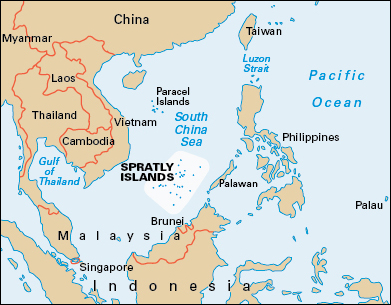Spratly Islands, also known as the Nansha Islands, are a group of low-lying coral islands and reefs in the South China Sea. The Spratlys lie about 650 miles (1,046 kilometers) south of China’s Hainan Island, about 300 miles (483 kilometers) east of Vietnam, and about 300 miles (483 kilometers) west of the Philippine island of Palawan.

Ownership of the Spratly Islands is disputed. The islands lie along major shipping lanes and have rich fishing waters. In addition, many experts believe that deposits of oil and natural gas may lie under the seabed beneath the islands. Today, China administers the Spratly Islands as part of Hainan Province. However, Brunei, Malaysia, the Philippines, Taiwan, and Vietnam claim ownership of some or all of the Spratlys and the surrounding area.
Vietnam claims that it established control over the Spratly Islands from the 1600’s to the 1800’s. In the 1930’s, the Spratlys came under French rule as part of French Indochina . During World War II (1939-1945), Japanese troops seized the islands. After the war ended, control of the Spratlys passed to China. In the late 1940’s, however, the Philippines claimed ownership of some of the islands closest to Philippine territory.
In the 1950’s, Vietnam, which had been a part of the colony of French Indochina , was divided in two. Communists controlled the north, and non-Communists controlled the south. North Vietnam initially recognized the Spratlys as belonging to China, which was a Communist ally. In 1975, North and South Vietnam united to form the Socialist Republic of Vietnam. Soon after, the Vietnamese government claimed ownership of the Spratlys and occupied several of the islands. In 1976, oil was discovered between the Spratlys and Palawan. As a result, international interest in controlling the region increased. In 1988, China seized several of the Spratlys that had been held by Vietnam.
In 2012, China established the city of Sansha on an island in the Paracel Islands group, which lies northwest of the Spratlys. Sansha’s government was given the responsibility of administering Chinese interests in the South China Sea, including the Spratlys. In 2016, a United Nations-appointed tribunal ruled that the region is neutral international territory and China’s claim to exclusive control over much of the South China Sea was unlawful. The tribunal found that China had violated the rights of the Philippines, particularly in the region of the Spratlys. The Chinese government opposed the ruling.
